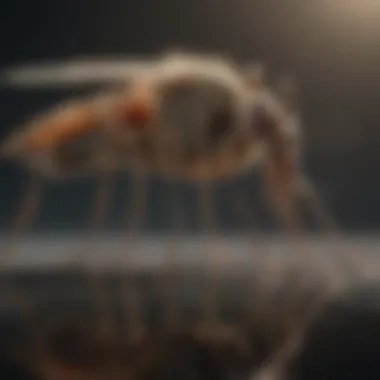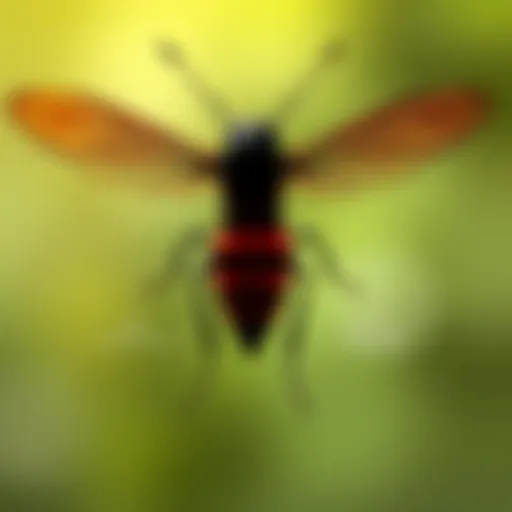Effective Mosquito Management Strategies in Toms River


Intro
Mosquito management in Toms River is a critical topic that intertwines public health, environmental conservation, and community action. This article will examine the multifaceted strategies employed to control mosquito populations, emphasizing the local authority's role and community involvement. Understanding these aspects not only helps residents protect themselves but also preserves the ecological balance in the region.
The following sections will dissect the methods of pest identification, prevention strategies, and treatment options, equipping homeowners with valuable knowledge to tackle mosquito issues effectively. This guide aims to provide practical insights relevant to daily life in Toms River, addressing both the risks mosquitoes pose and the proactive measures available to manage them.
Pest Identification
Identifying mosquitoes is the first step in managing them effectively. The primary species found in Toms River include Aedes, Culex, and Anopheles mosquitoes. Each species has distinctive traits and breeding habits.
Detailed descriptions of common pests
- Aedes Mosquitoes: This species is easily recognized by their white markings on legs and a lyre-shaped pattern on their thorax. They are aggressive daytime feeders.
- Culex Mosquitoes: Typically dull in color, these mosquitoes are active during dusk and dawn. They are known carriers of West Nile virus.
- Anopheles Mosquitoes: These are known for feeding at night. They are the primary vectors of malaria.
Signs and symptoms of infestations
Homeowners should be vigilant for the following indicators that suggest a mosquito problem:
- Increased presence of mosquitoes during certain times of day.
- Buzzing sounds around windows and doors, especially at night.
- Bite marks on family members or pets.
- Standing water in the vicinity, as it is a breeding ground.
Important Note: Proper identification is crucial, as different species may require different management strategies.
Prevention Strategies
Effective mosquito management begins with prevention. Here are several strategies that homeowners can adopt to minimize mosquito presence.
Home maintenance tips for pest prevention
- Eliminate Standing Water: Regularly check for and remove sources of stagnant water from your yard, such as in flower pots, bird baths, and clogged gutters.
- Trim Vegetation: Keep grass and shrubs trimmed to reduce resting sites for adult mosquitoes.
- Install Screens: Ensure windows and doors have functional screens to prevent mosquitoes from entering your home.
Natural deterrents and barriers
Several natural deterrents can be employed to keep mosquitoes at bay:
- Essential Oils: Oils such as citronella and eucalyptus are known to repel mosquitoes. Consider applying them in outdoor seating areas.
- Plants: Incorporate plants like lavender, marigold, and basil, which are natural repellent plants.
Treatment Options
When prevention methods fall short, treatment options are necessary to control the mosquito population.
Overview of chemical vs. natural treatments
Treatment methodologies can be broadly categorized into chemical and natural options:
- Chemical Treatments: These include insecticides such as pyrethroids, which are effective but may harm beneficial insects.
- Natural Treatments: Options like garlic sprays or diatomaceous earth can deter mosquitoes without harming the environment.
Step-by-step guides for DIY treatments
For those interested in taking control, here are a few simple DIY treatment methods:
- Mix Garlic Spray: Combine two teaspoons of garlic powder with water in a spray bottle. Apply around the yard to deter mosquitoes.
- Diatomaceous Earth: Sprinkle food-grade diatomaceous earth in areas where mosquitoes breed. Make sure to reapply after rain.
Engaging in these practices enhances the capacity to manage mosquito populations effectively, contributing to a healthier living environment.
Preamble to Mosquito Authority in Toms River
Effective mosquito management is essential for safeguarding public health and enhancing the quality of life in communities like Toms River. The Mosquito Authority plays a pivotal role in this initiative by implementing strategies that control mosquito populations and mitigate the risk of mosquito-borne diseases. This section introduces the key functions and historical background of the Mosquito Authority, laying the groundwork for understanding its influence in the area.
The Role of Mosquito Authority
The Mosquito Authority operates under a systematic approach aimed at controlling mosquito populations. This organization conducts regular surveillance to monitor mosquito breeding sites and populations. Using data collected from these efforts, the authorities can develop targeted mosquito control measures. They also educate the public on preventive measures which is crucial in reducing the breeding grounds in residential areas.
In Toms River, the roles of the Mosquito Authority include:
- Monitoring mosquito activity: Regular assessments help to understand peak seasons and breeding trends.
- Implementing control measures: This includes the application of both chemical and biological methods to minimize mosquito presence.
- Engaging the community: Workshops and informational campaigns raise awareness about understanding and controlling mosquitoes effectively.
Historical Context in Toms River
To comprehend the current strategies of mosquito management in Toms River, it is important to explore its historical context. Mosquito control efforts in the area have evolved significantly over decades. Initially, these efforts were rudimentary and reactive, focusing primarily on eliminating standing water to reduce mosquito habitat.


As knowledge about mosquito-borne diseases increased, the approach shifted. A more comprehensive strategy emerged, integrating public health perspectives. For instance, during outbreaks of diseases such as West Nile virus and Zika virus, Toms River adapted its strategies to not only focus on mosquito elimination but also on education and surveillance.
This historical evolution reflects a broader shift in public health tactics, where community involvement has become a cornerstone of effective mosquito management.
"Effective mosquito management requires a collaborative approach involving both authorities and community members to be successful."
Overall, understanding the role of the Mosquito Authority and its historical context enlightens residents of Toms River about the importance of mosquito control measures and promotes an informed community that is active in dialogue and participation.
Importance of Mosquito Control
Mosquito control is crucial for safeguarding public health and preserving the health of local ecosystems. In Toms River, the significance of managing mosquito populations is multifaceted. The implications extend beyond mere discomfort caused by bites; they encompass serious health risks and environmental balance.
Public Health Implications
Mosquitoes are known vectors for various diseases, including West Nile virus, Zika virus, and Eastern Equine Encephalitis. These diseases can affect anyone, especially vulnerable populations such as children and the elderly. According to the Centers for Disease Control and Prevention (CDC), mosquito-borne illnesses have seen an increase in certain areas, leading to heightened concern among public health officials.
Effective mosquito management can help in reducing the spread of these diseases. In Toms River, community health initiatives often include mosquito surveillance and control measures aimed at minimizing breeding sites. This proactive approach can significantly lower the incidence of these illnesses. For instance, residents who notice stagnant water near their homes can report it to local authorities, helping in early intervention.
"Preventive measures and community vigilance are key in stopping mosquito-related outbreaks before they begin."
Ecosystem Considerations
While the focus is often on health risks, ecological considerations play a vital role in mosquito management. Mosquitoes, as part of the food web, contribute to biodiversity. They serve as food for birds, bats, and other wildlife. Hence, a balanced approach to mosquito control is necessary to avoid disrupting these natural processes.
Methods like biological control—using natural predators such as fish that eat mosquito larvae—can effectively reduce mosquito populations without harm to other species. Additionally, maintaining clean water bodies and habitats can support beneficial wildlife while minimizing mosquito breeding.
In summary, the importance of mosquito control in Toms River is evident in its impact on public health and the local ecosystem. Strategies tailored to the unique characteristics of this region can promote healthier environments and healthier communities.
Methods of Mosquito Control
Mosquito control methods are crucial for managing local populations effectively. In areas like Toms River, where mosquito-borne diseases can pose significant health risks, understanding these methods is essential. Each control strategy offers specific benefits and addresses various elements of mosquito ecology. A mixed approach—utilizing chemical, biological, and physical controls—can enhance overall effectiveness.
Chemical Controls
Chemical controls play a prominent role in mosquito management. This method involves the use of insecticides designed to reduce mosquito populations. These chemicals can be applied in various forms including sprays, fogs, or granules. When executed properly, they can drastically reduce the adult mosquito populations and larvae in standing water.
Some benefits of chemical controls include their immediate impact. Programs often target specific areas experiencing outbreaks. However, it is important to consider the environmental implications of chemical usage.
Regular monitoring of chemical residue can help maintain safety standards. One must also bear in mind that over-reliance on chemicals can lead to resistance development. Therefore, integrating multiple strategies together with chemical controls is recommended.
Biological Controls
Biological controls focus on the use of natural predators and organisms to manage mosquito populations. This method can be particularly effective in aquatic environments where mosquitoes breed. Introducing species like Gambusia affinis, known as the mosquito fish, is one common practice. They feed on mosquito larvae, thereby keeping their numbers low.
Another approach involves the use of bacteria, such as Bacillus thuringiensis israelensis. This bacterium is effective against mosquito larvae and is safe for humans and other wildlife. Biological controls are often favored for their environmentally friendly nature. They support an ecosystem approach to mosquito management.
Physical Barriers
Physical barriers serve as preventive measures to reduce encounters between humans and mosquitoes. This includes installing screens on windows and using mosquito nets in residences. These barriers act as the first line of defense.
Landscaping can also help by minimizing standing water where mosquitoes breed. These control methods can be implemented at relatively low cost and offer direct protection. However, they are dependent on consistent maintenance to remain effective. Regularly checking and repairing any breaches in physical barriers ensures their ongoing functionality.
Every method of mosquito control plays a part in a comprehensive management strategy. By combining several approaches, residents of Toms River can tackle the challenges posed by mosquitoes more effectively.
Regulations Governing Mosquito Control
Effective mosquito management in Toms River is supported by various regulations that aim to ensure public health safety and ecological balance. Regulations play a crucial role in shaping how mosquito control measures are implemented, establishing guidelines for both local authorities and residents. Adherence to these regulations not only mitigates the risk of mosquito-borne diseases but also promotes community awareness about responsible practices.
Local Regulations
Local regulations in Toms River are designed to address specific needs of the community while considering the unique environmental factors of the region. These regulations mandate strategies for mosquito breeding site management, including:
- Waste Management: Residents are encouraged to eliminate standing water, where mosquitoes breed. This includes regular cleaning of gutters, and proper disposal of containers that collect rainwater.
- Public Spaces: Parks and common areas are subject to treatments that reduce mosquito populations. Local authorities develop routines for inspections and treatment, ensuring recreational areas remain safe for use.
- Community Engagement: Local laws may require mosquito control programs to engage residents through educational outreach, fostering a sense of collective responsibility.
These regulations provide a framework that minimizes mosquito populations, thus reducing the chances of outbreaks.
State and Federal Guidelines
At a broader level, state and federal guidelines complement local regulations by setting minimum standards for mosquito control practices. These guidelines include:
- Environmental Protection Standards: State regulations mandate that mosquito control methods comply with environmental safety measures to protect local ecosystems. This includes using environmentally friendly chemicals that do not harm beneficial insects or aquatic life.
- Health Surveillance Programs: Federal guidelines often involve coordinated health surveillance, helping to track disease outbreaks and measure the effectiveness of mosquito control methods. In Toms River, these programs are crucial for understanding the risks posed by mosquito populations.
- Best Practices Protocol: Both state and federal resources provide best practice protocols for chemical use, application methods, and safety precautions to ensure the health of both the public and the environment.


Ensuring compliance with these guidelines is vital for effective mosquito management in Toms River. Regulatory oversight not only safeguards public health but also promotes the sustainable use of resources.
"By balancing local initiatives with state and federal regulations, communities can achieve better outcomes in mosquito control while protecting their natural habitats."
In summary, the outlined regulations guide both residents and agencies in Toms River, ensuring that all methods of mosquito control are implemented safely and effectively. This cohesive approach reinforces the effectiveness of the strategies deployed against mosquito populations.
Role of Technology in Mosquito Management
The integration of technology into mosquito management represents a significant advancement in the effectiveness of control measures. It allows for real-time data collection, analysis, and strategic implementation of treatments. In Toms River, technology facilitates precision in targeting mosquito populations while also minimizing impacts on non-target species and the environment. Thus, understanding this role is essential for anyone interested in mosquito control efforts.
Tracking and Surveillance
Accurate tracking and surveillance are crucial components of mosquito management strategies. Utilization of advanced technologies such as Geographic Information Systems (GIS) and remote sensing enhances the capability to monitor mosquito populations. For instance, GIS can help identify breeding sites and map high-density areas where mosquitoes are prevalent.
This type of data aids local authorities in making informed decisions regarding treatment applications. Moreover, the implementation of traps equipped with sensors provides continuous monitoring of mosquito activity. These traps can notify authorities when mosquito populations surpass certain thresholds, prompting immediate action. Utilizing smartphone applications for reporting mosquito sightings encourages community participation and fosters a proactive approach to management.
"Effective surveillance allows for prompt intervention, reducing risks associated with mosquito-borne diseases."
Advanced Treatment Methods
The evolution of treatment methods is significantly influenced by technological advancements. Innovative solutions, such as drones for aerial applications, have emerged to deliver targeted treatments in hard-to-reach areas. This method ensures that the insecticides are applied precisely where they are needed, optimizing pesticide use and reducing environmental exposure.
In addition, biotechnological methods, like genetically modified mosquitoes, are at the forefront of research. These genetically altered mosquitoes can either reduce the reproduction rate of wild populations or render them incapable of transmitting diseases. Although still under scrutiny, these methods represent a forward-thinking approach to mosquito control.
Furthermore, automated systems for chemical release, adjustable according to real-time data, improve the effectiveness of interventions. These systems not only maximize efficiency but also minimize waste, contributing to a more sustainable approach to mosquito management.
Community Involvement in Mosquito Management
Community engagement is critical in the fight against mosquito populations. In Toms River, local initiatives that promote public participation create a united front against the challenges posed by these pests. Active community involvement leads to better communication between residents and authorities, fostering a sense of shared responsibility.
Not only does it enhance the efficacy of mosquito control efforts, but it also boosts awareness of the potential health risks that mosquitoes present. When residents understand the importance of combatting mosquitoes, they are more likely to engage in preventive measures around their homes and in their neighborhoods.
Involving the community in mosquito management has various benefits:
- Increased awareness about mosquito-borne diseases.
- Enhanced collaboration with local authorities, leading to timely response to mosquito issues.
- Empowered citizens who take initiative in promoting hygiene and reporting problems.
Through public education and vigilant reporting systems, communities can play a pivotal role in mosquito management efforts.
Public Education Initiatives
Public education is a fundamental component of effective mosquito management strategies. Initiatives focusing on educating citizens about the life cycle of mosquitoes, their breeding habits, and preventive measures can significantly reduce their numbers. In Toms River, local organizations often host workshops or information sessions aimed at enlightening the public on how to manage standing water and maintain a mosquito-free environment.
Key elements of such initiatives include:
- Distribution of educational materials, such as pamphlets and infographics.
- Organizing community clean-up days to eliminate potential mosquito breeding grounds.
- Collaborating with schools to educate children and families about mosquito prevention.
These programs not only inform but also engage the community, encouraging a proactive approach to the management of mosquito populations.
Community Reporting Systems
Implementing community reporting systems is another effective strategy in mosquito management. These systems allow residents to report mosquito sightings and breeding areas directly to local authorities. In Toms River, this can be done through online platforms or dedicated hotlines. By creating mechanisms for reporting, communities contribute valuable data that can guide local mosquito control efforts.
Benefits of community reporting systems include:
- Prompt responses from local authorities based on real-time data.
- Identification of problem areas that require immediate attention.
- Opportunities for residents to engage and take part in the solution.
In summary, community involvement is vital for effective mosquito management in Toms River. Public education initiatives and efficient reporting systems empower residents to take an active role in safeguarding their neighborhoods, ultimately leading to a healthier environment for all.
Challenges in Mosquito Control
Effective mosquito management presents several challenges that require ongoing attention and innovative strategies. Understanding these challenges is crucial for developing practical solutions that safeguard public health and maintain community well-being. In Toms River, mosquitoes function as transmitters of diseases and pose risks that can impact daily life significantly. Thus, recognizing the challenges within mosquito control can lead to more informed practices and community engagement.
Resistance Development
One major issue in mosquito control is the development of resistance to chemical treatments. Mosquito populations can adapt to insecticides over time, reducing the effectiveness of these controls. This phenomenon often results from the over-application of chemicals which encourages the survival of the more resilient insects. When previously effective products such as DEET or Pyrethroids are used repetitively, they lose their potency against certain mosquito strains.
Here are some key points to consider about resistance development in mosquito populations:
- Genetic Adaptation: Mosquitoes can undergo genetic changes that allow them to survive chemical exposure.
- Monitoring and Management: Ongoing testing is crucial to identify resistance patterns, thus leading to informed decisions on treatment alternatives.
- Integrated Pest Management: This approach combines various control tactics to manage mosquito populations effectively, rather than relying solely on insecticides.
"Sustainable mosquito control requires understanding and adapting to resistance patterns, emphasizing a more holistic approach rather than reliance on chemicals alone."
Climate Change Impact


Climate change adds another layer of complexity to mosquito management. Increasing temperatures and changing precipitation patterns contribute to ideal breeding conditions for mosquitoes. Warmer climates extend mosquito breeding seasons and expand their habitats. These changes have significant implications for public health strategies in Toms River.
Some considerations regarding climate change impact include:
- Extended Breeding Seasons: Higher temperatures can lead to more generations of mosquitoes each year.
- Increased Range: New species may establish themselves in areas previously unaffected, leading to greater health risks.
- Public Health Preparedness: Authorities must adapt and enhance surveillance systems to monitor mosquito populations more accurately.
In summary, challenges in mosquito control are multifaceted. Resistance development necessitates a deviation from traditional methods, employing an integrated framework to maintain control. Climate change presents a growing threat that calls for innovative public health strategies and community awareness to adapt to these changes effectively.
Case Studies and Success Stories
In this examination of mosquito management in Toms River, the section on case studies and success stories is crucial. They provide tangible examples that reflect the effectiveness of various mosquito control strategies. By examining these cases, we can learn not only from successful programs but also from those that did not yield the expected results. This dual perspective helps refine future efforts and enhances overall management practices. It is essential to understand how different regions tackle similar challenges to develop a tailored approach within Toms River.
Effective Programs in Similar Regions
Analyzing the mosquito management programs in regions with comparable climates and ecosystems can provide valuable insights. For instance, programs in coastal areas like Cape May, New Jersey, have implemented successful community-centered strategies. These initiatives include coordinated spraying schedules and public education campaigns, resulting in a notable reduction in mosquito populations.
A key feature of successful programs is the collaboration between local governments and residents. Cape May's approach included:
- Regular community meetings to discuss mosquito activity.
- Informative pamphlets distributed to residents, detailing prevention methods.
- Active engagement of volunteers in monitoring local mosquito habitats.
By adopting similar collaborative efforts, Toms River can harness community support and knowledge. This not only promotes awareness but also empowers residents to play an active role in mosquito control.
Lessons Learned from Failures
While success stories are motivating, it is equally important to analyze cases that have failed. An instance from Texas serves as a cautionary tale. The area faced criticism due to the excessive use of chemical treatments without community input. This led to mistrust among residents. Over time, an increase in mosquito-borne diseases was observed despite the treatments.
Several lessons can be extracted from this failure:
- Community Engagement: Involving residents in mosquito management decisions is critical. Programs should be transparent and inclusive to build trust.
- Balanced Strategies: Relying solely on chemical controls is insufficient. A multifaceted approach integrating biological and physical methods is essential for sustainable management.
- Monitoring and Adjustment: Continuous monitoring of mosquito populations and health impacts can help adapt strategies effectively.
Future Directions in Mosquito Control
Future directions in mosquito control are vital to the ongoing efforts in managing mosquito populations effectively in Toms River. As environmental and health challenges evolve, so must the strategies we use to combat these pests. Innovative approaches and policies help ensure sustainable mosquito management, minimize risks of disease transmission, and foster community involvement. This section will delve into two key aspects: Innovative Research and Development and Policies for Sustainable Management.
Innovative Research and Development
Research aimed at improving mosquito control techniques is essential. Innovative methods are being studied, such as genetic modification of mosquitoes to decrease populations. For instance, scientists are investigating the use of CRISPR technology to alter mosquito genetics in a way that makes them less capable of carrying diseases. This technique could significantly reduce the incidence of mosquito-borne illnesses.
Additionally, non-toxic repellents and environmentally friendly larvicides are being developed. These advancements reduce environmental impact while maintaining effectiveness. Research into behavioral patterns of mosquitoes also plays a crucial role, as understanding their habits leads to more targeted and effective control methods.
Being aware of the relevance of research can help residents make informed decisions. New findings are often shared through community workshops and local publications, keeping people updated about available options and techniques that might work in their yards.
Policies for Sustainable Management
Sustainable management is increasingly important in mosquito control. This involves creating and implementing policies that prioritize ecological balance while addressing public health needs. It requires cooperation and regulation at local and state levels. Developing guidelines focused on integrated pest management (IPM) approach emphasizes using multiple tactics for long-term control rather than relying solely on pesticides.
A few key elements often considered in these policies include:
- Promoting community engagement through education about mosquito breeding and prevention practices
- Establishing guidelines for the use of chemicals to ensure safety for residents and non-target species
- Investing in green spaces and maintaining natural habitats that can deter mosquitoes rather than encourage their proliferation
- Enhancing monitoring systems to track mosquito populations and disease outbreaks more effectively
Sustainable management is fundamental for protecting public health while preserving our environment.
The future of mosquito control in Toms River lies in a combination of innovative research and carefully crafted policies. By remaining committed to exploring new methods and engaging in sustainable practices, Toms River can navigate the complexities of mosquito management effectively.
End
In this article, we explored various aspects of mosquito management in Toms River, emphasizing its significance from multiple angles. The management of mosquito populations is not merely a matter of comfort but a crucial public health concern. Understanding the practices and protocols in place can greatly contribute to overall community well-being. Local authorities play a key role in implementing these strategies, as effective management directly impacts the risk of mosquito-borne diseases.
In Toms River, multiple layers of mosquito control measures are present, including chemical treatments, biological controls, and physical barriers. Each method offers distinct advantages, yet the integration of these practices is vital for sustainable results. The challenges that arise in mosquito management—such as evolving resistance and climate change—demand awareness and innovative approaches.
Summary of Key Points
- Public Health Risks: Effective mosquito management is fundamental in reducing the incidence of mosquito-borne diseases that pose health risks to residents.
- Community Engagement: Local communities must take active roles in reporting mosquito issues and participating in educational efforts to foster better understanding.
- Sustainable Practices: The integration of various control methods is essential to effectively manage mosquito populations while minimizing environmental impact.
By synthesizing these points, it becomes evident that a multi-faceted approach to mosquito management is imperative for the health and safety of the Toms River community. Every effort made in this regard contributes to a more sustainable living environment.
Call for Continued Awareness and Action
As stakeholders in this ongoing battle against mosquitoes, it is vital to maintain awareness of how these insects impact our lives. Public education initiatives can empower individuals to take proactive measures in their own yards, such as eliminating standing water and investing in repellents.
Additionally, being informed about local mosquito control programs and participating in community efforts can amplify the effectiveness of these initiatives.
Action Steps for Residents:
- Regularly check and eliminate standing water in personal properties.
- Stay informed about local mosquito control treatments and schedules.
- Engage in community discussions to share concerns and solutions regarding mosquito management.
"The fight against mosquitoes is not a solitary endeavor; it requires a committed community and informed individuals to foster lasting change."
Continual action, awareness, and community participation are the backbone of effective mosquito management in Toms River. Each small effort contributes to the larger goal of safeguarding public health and enhancing the quality of life in the region.



